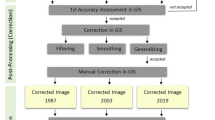Abstract
Traditional grazing lands in the Indian arid zone can be identified and mapped, reliably and reasonably within ±10% accuracy, through Landsat TM false colour composite of bands 2,3,4. Comparative study of Landsat TM and the Survey of India topographical maps revealed reduction in the areal extent of the grazing lands in the Jodhpur district up to 9 to 30% over a period of 28 years, between 1958 and 1986, due to the human activity like cultivation and urbanisation resulting in the desertification of the adjoining agriculturallands.
Similar content being viewed by others
References
Aldrich, R.C. (1975). Detecting disturbances in a forest environment.Photogrammentric Engineering and Remote Sensing, 41: 39–48.
Anderson, J.R. (1977). Landuse and land changes — a frame work for monitoring.Journal of Research — U.s. Geological Survey, 5: 143–153.
Anderson, J.R., Ernest, E.H. and John, T.R. 1978. A landuse and land-cover classification system for use with remote sensor data.Geological Survey Professional paper 964. U.S. Government Printing office, Washington D.C.
Anonymous 1986.Manual of Procedure for wastelands mapping using Remote Sensing Techniques. National Remote Sensing Agency, Hyderabad, 50 pp.
Bichsel, M. and Dias, H. 1985. Monitoring natural forest cover changes in Sri Lanka.Proceedings of the Sixth Asian Conference on Remote Sensing, Hyderabad: 77–83.
Gaydos, L. and Willard, L.W. 1978. Inventory of landuse and land cover of Puget Sound region using Landsat digital data.Journal of Research — U.S. Geological Survey, 6: 807–814.
Kachhwaha, T.S. 1984. Application of satellite remote sensing techniques in delineating and quantifying grassland and forest cover for wildlife management in Dudwa National Park, U.P., Indian.Proceedings of the Fifth Asian Conference on Remote Sensing, Kathmandu: R-10-1 to R-10-7.
Kachhwaha, T.S. 1985. Temporal monitoring of forest land for change detection and forest cover mapping through satellite remote sensing.Proceedings of the Sixth Asian Conference on Remote Sensing, Hyderabad: 77–83.
Mann, H.S., Malhotra, S.P. andShankaranarayan, K.A. 1977). Land and resource utilisation in the arid zone.In Desertification and its control. Indian Council of Agricultural Research, New Delhi, 89–101 pp.
Myers, V.I. 1983. Remote sensing application in agriculture.In Manual of Remote Sensing. American Society of Photogrammetry, Falls Church, VI, 2111–2228.
Nelson, R.F. 1983.Detecting forest canopy change using Landsat. NASA/TM-/83918, Goddard Space Flight Centre, Greenbelt, M.D.
Patil, D.N., Sawant, S.B. and Dey, b. 1986. Changes in natural pattern of some river basins in Maharashtra, India — A study based on remote sensing technique.Proceedings of International Seminar on Photogrammetry and Remote Sensing for the Developing New Delhi: T.4-5/5.1-T.4-5/5.13.
Shankaranarayan, K.A. and Singh, S. 1979.Application of Landsat data for natural resource inventory and monitoring of desertification. SDSU-RSI-VISP-79-17 South Dakota State University, Brookings, SD, 136 pp.
Author information
Authors and Affiliations
About this article
Cite this article
Sharma, K.D., Singh, S., Singh, N. et al. Satellite remote sensing for detecting the temporal changes in the grazing lands. J Indian Soc Remote Sens 17, 55–59 (1989). https://doi.org/10.1007/BF03007242
Received:
Revised:
Issue Date:
DOI: https://doi.org/10.1007/BF03007242




